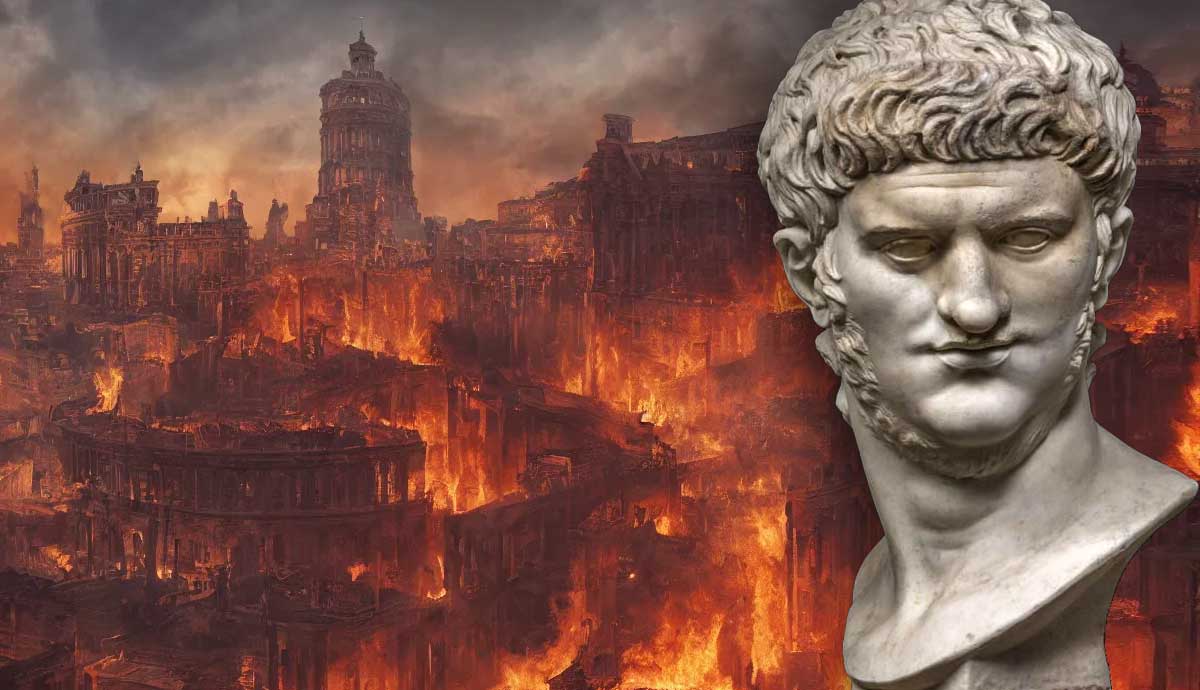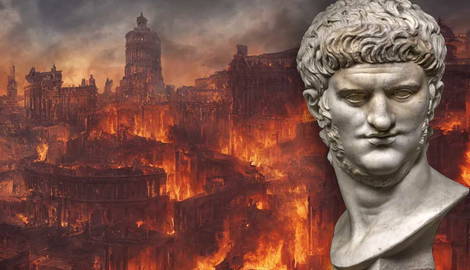
Emperor Nero is well known for his acts of madness and tyranny, with the Great Fire of Rome being one of his most infamous acts. Yet, while the Great Fire was a devastating event that destroyed much of the Roman Empire’s capital, Nero was not the one responsible for the calamity. The emperor did not make the order, and he certainly did not play the fiddle (or the lyre) while Rome was burning.
However, Nero made most of the devastating event and, in the aftermath of the Great Fire, embarked on several grandiose construction projects, including the opulent palatial complex – Domus Aurea. The emperor’s building spree on the ashes of the smouldering city angered his political enemies, including the Senate of Rome. Following his suicide in 68 CE, the senators (many of them historians) exploited the Great Fire of Rome in their quest to tarnish emperor Nero’s name for posterity.
The Great Fire of Rome Happened During Nero’s Reign

The Great Fire of Rome, one of most tragic events in the city’s long history, happened in the tenth year of emperor Nero’s reign. The fire broke out on the night of July 18, 64 CE, in the eleventh district, the area that hosted the great arena for chariot races – the Circus Maximus. According to historian Tacitus, our best source, the first flames appeared in the merchant shops near the grand arena, from where the fire spread quickly, fueled by strong wind and dry summer weather. The Great Fire of Rome raged for six days and seven nights, destroying or damaging ten of the fourteen districts. The flames claimed hundreds of lives, left thousands more homeless, and left two-thirds of the city in ruins.
Nero’s Enemies Blamed the Emperor for the Fire

Nero’s enemies used the disaster against the emperor. Nero was blamed for the fire, either for ordering it or for neglecting it, and for indifference to the suffering of those affected by the disaster. Probably the most severe of the accusations was that the emperor was using the Great Fire of Rome for his artistic pursuits. While the ancient city burned, the emperor observed the event from the safety of his Palace, played the lyre, and sang of the destruction of Troy, comparing the present misfortune with the calamities of antiquity. A tempting tale, but as often in history, too good to be true.
Nero Was Not Responsible for the Disaster

To start with, according to the most reliable source – Tacitus – Nero had a strong alibi. He was not in Rome when the fire started. The 26-year-old emperor was relaxing at his seaside villa in Antium (modern-day Anzio), 50 km (31 miles) from Rome. Upon hearing the terrible news, the emperor immediately returned to the capital, where he personally led the relief efforts. Not something you would expect from an arsonist.
The Emperor Assisted the Citizens of Rome

The emperor also assisted the victims. According to Tacitus, the emperor opened the Campus Martius and the public building as a shelter for the homeless, going as far as to allow the use of his private gardens. And after the blazing inferno was finally contained, Nero offered cash incentives to ensure Rome’s rapid recovery. Emperor Nero also passed and enforced new fire regulations. The Great Fire of Rome was not the first time the ancient city went up in flames. No fewer than six fires were recorded in just the first half of the first century. But the fire of 64 CE was undoubtedly the worst. Thus, Nero played a crucial role in preventing any similar disaster in the future.
Nero, However, Exploited the Fire to Build Domus Aurea

Despite the emperor’s efforts, many blamed Nero for burning Rome. It did not help that the emperor exploited the fire for his ambitious construction program. The highlight was the majestic new palace – the Domus Aurea. The “Golden House,” built in the area devastated by the fire, was a lavish and huge palatial complex containing many buildings, landscaped gardens, orchards, vineyards, and even an artificial lake. The rooms were covered in gold and decorated with precious stones and gems.
No wonder the senators jumped on the opportunity to use the opulent structure to undermine their hated rival. However, their anger may be misplaced, as according to recent findings, the massive complex seems to be not a private but a public building open to the people of Rome. After all, Nero was widely popular among the common folk.
He Also Used the Fire to Persecute the Christians

To suppress the rumors, and prevent violence, Nero had to find a scapegoat for the devastating calamity that ruined Rome. The answer was a new and unpopular religious sect, considered a troublemaker and threat by the Roman authorities – the Christians. According to Tacitus, on the emperor’s orders, the Christians were mass arrested, nailed to the cross, thrown to the beasts, or burned alive as “human torches that illuminated the night.” Tacitus’ account, however, is problematic, and it seems that Nero’s persecution of the Christians was inflated by the early Christian historians, who found the hated pagan emperor an easy target in the Empire of Constantine the Great and his heirs.
The Great Fire of Rome Was Used to Demonize Emperor Nero

While most likely accidental, the Great Fire of Rome could easily be exploited by emperor Nero’s numerous enemies. His ambitious building program on the ashes of the still smoldering city, including the extravagant Domus Aurea, made it easier for Nero’s rivals to undermine the emperor’s authority, eventually leading to Nero’s suicide. Following the bloody civil war, the new Flavian dynasty used the Great Fire of Rome to vilify both Nero and his Julio-Claudian dynasty. The accounts of senators and historians such as Suetonius and Cassius Dio forever sealed the fate of the hapless emperor, making him a tyrant and arsonist of Rome. And after the Christian takeover of the Roman Empire, Nero’s persecution of Christians made him the Antichrist.
We should not forget that the winners are the ones who write the history. Nero was an emperor, the most powerful man in the Roman Empire. But he lost the battle against the well-entrenched and powerful senatorial elite. Centuries later, the long dead emperor also lost the fight against the Christians. Becoming a tyrant, murderer, Antichrist, and the architect of the Great Fire of Rome.










